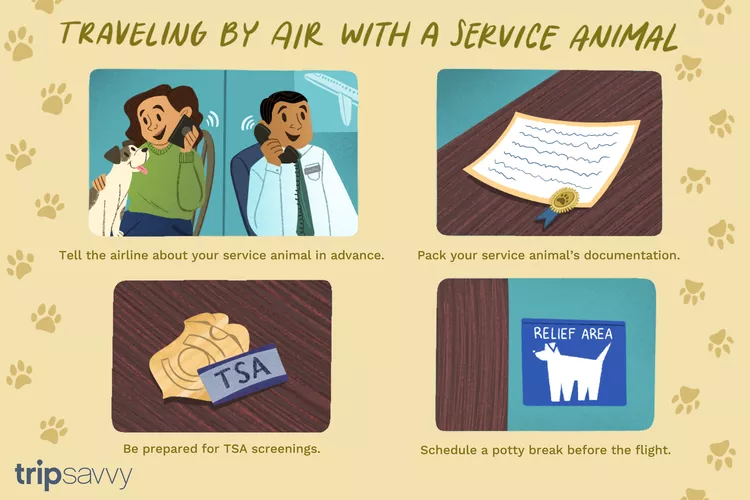Summary of Traveling with a Service Animal
Traveling by air with your service animal is a straightforward process. You and your service animal can travel together as long as your service animal is small enough to sit by your feet or under the seat in front of you without obstructing aisles and exit pathways, provided it is a type of animal permitted on US air carriers. Preparing for the airport security screening process will help you and your service animal go through without difficulty.
Familiarize yourself with the applicable regulations and procedures before you go to the airport.
Quarantine Regulations
If you are traveling to an island destination, such as Hawaii, Jamaica, the United Kingdom, or Australia, you should carefully review animal quarantine rules and procedures for guide and service animals. This is true even if you are only passing through the airport. You may need to begin the compliance process several months before your departure date, particularly if you are visiting the UK.
TSA Procedures
The Transportation Security Administration (TSA) must comply with all federal regulations pertaining to service animals. The TSA has established procedures for screening service animals, with specific guidelines for service dogs and service monkeys. You must tell the screening officer that you are traveling with a service animal, and both you and your service animal must go through a metal detector and/or be patted down. If you know what to expect during the airport security screening process, you and your service animal will be able to quickly go through the security checkpoint.
Airline Service Animal Policies
Your airline may have established specific policies for passengers traveling with service animals. For example, American Airlines asks passengers to check in one hour early if they are accompanied by a service animal. They also require 48 hours’ notice from passengers planning to bring service animals onto the aircraft. This helps airline personnel seat passengers with service animals in appropriate areas, such as bulkhead seats, and position them far from passengers with animal allergies. Call your airline or consult its website as far in advance as possible to find out how to notify your airline of your upcoming trip.
Travel and Federal Law
Passengers traveling on US carriers with service animals are protected under the Air Carrier Access Act, also known as Title 14 CFR Part 382. Under these laws, airline personnel cannot require you to transport your service animal in the cargo hold unless it is too large to sit at your feet under the seat in front of you during the flight. Airline employees may ask you about your service animal and may require you to show documentation provided by a licensed medical professional if you are traveling with an emotional support animal or psychiatric service animal. Large service animals may need to travel in the cargo hold unless you are able and willing to buy a second ticket to accommodate your animal companion. In addition, US law does not require airlines to transport snakes, ferrets, rodents, or spiders, even if they are considered service animals, because they can carry diseases.
Emotional support animals are considered to be in a different category than service animals under the Air Carrier Access Act. You must provide written documentation of your need for an emotional support animal from your licensed mental health professional, and your airline may require you to give at least 48 hours’ notice that you will be traveling with your emotional support animal.
Prepare for Airport Security
As you pack your bags and get ready to head toward the airport, take a few extra minutes to make sure you are ready to go through airport security with your service animal. If you travel frequently, consider signing up for TSA PreCheck.
Also, remember to tell your airline about your service animal no later than 48 hours before your flight.
Remember that you, too, must go through airport security. Wear slip-on shoes, if possible, and be ready to take your laptop out of its case. Empty your pockets. Put your change, keys, and other metal objects into your carry-on bag to avoid setting off the metal detector.
Keep your printed or electronic ticket, identification, passport, and service animal documentation in an easy-to-reach spot. You will need to produce these items at least twice during a typical security screening.
Take a Potty Break
Once you are through security, take your service animal to the airport’s pet relief area before you check in for your flight. The pet relief area may be far away from your gate, so be sure to allow plenty of extra time.
Be Flexible
As you go through the screening area, you may be asked to walk through the metal detector with your service animal rather than separately. This means that both of you will need extra screening if the alarm sounds. If you travel with a service monkey, you may be asked to remove its diaper. Remember that TSA security screeners are trained to let you handle your service animal; they should not touch it or talk to it. They will, however, screen any saddlebags your service animal wears and wand or pat down its leash and other accessories. Security screeners will expect you to control your service animal during this process.
Resolve Problems Appropriately
Every airline has a Complaint Resolution Officer (CRO) who should be available in person or by telephone to help resolve problems. You can ask to speak to the CRO if you are having difficulty with your airline’s boarding process. In addition, the US Department of Transportation has an aviation consumers’ disability hotline you can call if you are experiencing difficulty. The telephone number is (800) 778-4348 and the TTY number is (800) 455-9880.
On the Airplane
As you board, guide your service animal to your seat or ask a flight attendant to direct you. You may be asked to move if your assigned seat is in an exit row or if you are seated near a passenger with animal allergies. The flight attendants should make every effort to accommodate both you and any allergic passengers. Remember to ask to speak to the CRO if major problems arise.
The Bottom Line
Know your rights under the law and bring a smile with you to the airport. Preparation, organization, good manners, and flexibility will help you get through airport security and onto your airplane without problems.




